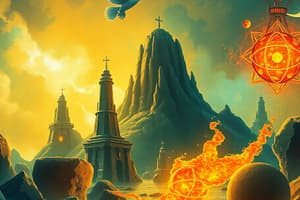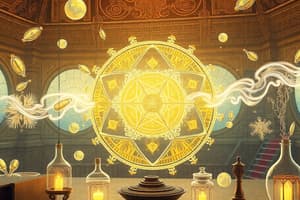Podcast
Questions and Answers
What does the word 'atom' mean?
What does the word 'atom' mean?
Uncuttable
Who first explained the difference between elements?
Who first explained the difference between elements?
John Dalton
What did Dalton's theory propose about atoms?
What did Dalton's theory propose about atoms?
- Atoms are made up of even smaller particles.
- Atoms are the largest particles of an element.
- All atoms of a given element are identical. (correct)
- Atoms of different elements are the same.
Atoms were shown to consist of two electrically charged parts: ____ and ____.
Atoms were shown to consist of two electrically charged parts: ____ and ____.
What did J.J. Thompson propose about atoms?
What did J.J. Thompson propose about atoms?
What is the Plum Pudding Model?
What is the Plum Pudding Model?
What significant experiment did Ernest Rutherford conduct in 1909?
What significant experiment did Ernest Rutherford conduct in 1909?
What does the Rutherford atomic model state about atoms?
What does the Rutherford atomic model state about atoms?
The atomic number is equal to the number of ____ in an atom.
The atomic number is equal to the number of ____ in an atom.
The mass number of an atom is calculated as the number of protons plus the number of ____.
The mass number of an atom is calculated as the number of protons plus the number of ____.
What are isotypes?
What are isotypes?
An electrically neutral atom has different numbers of electrons and protons.
An electrically neutral atom has different numbers of electrons and protons.
Flashcards are hidden until you start studying
Study Notes
Early Ideas of Atomic Structure
- The term "atom" derives from the Greek word meaning "uncuttable."
John Dalton and Elements
- John Dalton first articulated the differences between elements around 1800.
Dalton's Atomic Theory
- Proposed atoms as tiny, indivisible spheres.
- Atoms are the smallest units of an element retaining its properties.
- All atoms of the same element are identical, while those of different elements vary.
Structure of Atoms
- 1800s experiments revealed atoms are composed of two electrically charged components.
- Positive charges identified as protons, while negative charges are electrons.
- J.J. Thomson provided an explanation for these findings.
Thomson's Plum Pudding Model
- Describes the atom as a positively charged "pudding" with negatively charged particles (electrons) embedded within.
Rutherford's Gold Foil Experiment
- Conducted by Ernest Rutherford in 1909, significantly shifted concepts of atomic structure.
Rutherford's Atomic Model
- Proposes that atoms consist primarily of empty space.
- Most of an atom's mass is concentrated in a small nucleus at its center.
- The nucleus contains positively charged protons and neutral neutrons, with negative electrons orbiting around it.
Atomic Number
- Defined as the number of protons in an atom.
- The atomic number uniquely identifies an element and remains constant.
Atomic Mass
- Calculated as the sum of protons and neutrons in the nucleus.
- Mass Number = Protons + Neutrons.
Isotopes
- Atoms of the same element can vary in the number of neutrons.
- Example: Most hydrogen atoms have no neutrons, but some contain one neutron, resulting in different mass numbers.
Charges in Atoms
- An electrically neutral atom maintains equal numbers of electrons and protons.
- It is possible to change the electron count, thereby altering the atom's charge.
Studying That Suits You
Use AI to generate personalized quizzes and flashcards to suit your learning preferences.




